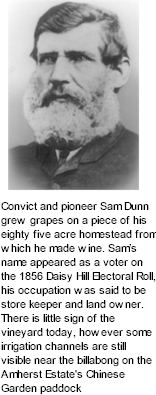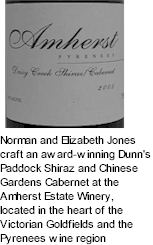


Amherst is a town rich in history. It is accredited with the first official gold find in Victoria in 1851 setting off a gold rush stretching all over central Victoria. Although much of the architecture constructed during the gold rush days was destroyed by bush fires, there are still many examples of some of the original buildings at nearby Talbot, just 4km away.

The district's history with viticulture is also long and rich. In 1896 Signor Bragaro, the Viticultural expert to the Department of Agriculture, was invited by the Talbot Borough Council to visit the nearby township of Talbot and give instruction in pruning vines to vineyard operators Messrs. S. Dunn and Cayzer's, as well as other local vignerons. Considerable interest was shown, with grapegrowers coming from as far away as Avoca and Wareek to take lessons.
Mr. Bragato answered many questions put to him, and he distributed illustrated pamphlets on grafting vines. Samples of wine were submitted, and Mr. Bragato expressed the opinion that the district was eminently suited to producing a high class wine. The Mayor thanked Mr. Dunn and Mr. Cayzer for placing their vineyards at the disposal of the public, and Mr. Bragato for his courteous and able instruction, which he was sure would be of great value to those people interested in the wine industry. In reply Mr. Bragato said he was pleased to have again visited the local district and he was of the opinion that an important winegrowing industry would develop.
The Amherst Estate vineyard is also deeply rooted in early Australian folklore. Samuel Dunn was found guilty in 1837 of stealing one lamb of the price of ten shillings, and was sentenced to be transported to Australia for the term of his natural life. In 1851 he married 18 year old Mary Therese Taaffe who'd arrived in Adelaide as one of one hundred and ninety five Irish orphan girls, after her parents had died from fever during the Irish famine. Sam and Mary walked from Adelaide to Amherst pushing a wheelbarrow carrying their belongings. Sam purchased land from the Government and they settled on the piece of land that was later to become the Dunn’s Paddock, and Amherst Estate vineyard.

Amherst Estate currently has ten acres under vine consisting 80% shiraz, 15% cabernet and 5% chardonnay grapes. The vineyard is on old alluvial gold fields dating back to the 1850s, and diggings can still be seen around the property in the quartz rich soil. The premium Dunns Paddock Shiraz and Chinese Gardens Cabernet Sauvignon pay tribute to the rich history on which the vineyard is sited. Samuel Dunn was an escaped convict turned good, who was the first to cultivate the land in the early 1850s, while the Chinese Garden is where a Chinese market garden provided food to the flourishing gold fields of yesteryear.
Amherst Winery makes a Shiraz, a Cabernet and a Chardonnay from estate grown grapes, the wines have featured in some of Melbourne's top restaurants. Dunn's Paddock Shiraz shows a dark colour, incredible aroma of dark berries, morello cherry, earth, eastern spices, cooking chocolate and game meats. Wonderful entry with a rich, sweet flavour that shows amazing savouriness and exotic middle flavours followed by a gripping but balanced tannin. At the finish is the black pepper that rounds it out.
Amherst's Reserve Shiraz is made from the best parcels of fruit left on the vine for longer than usual to enhance the intensity of the flavour and colour. The intense blackcurrant flavours of Amherst's Chinese Garden's Cabernet are complemented by maturation in French and American Oak barrels for many months, whilst the Daisy Creek Cabernet is a wonderful light drinking wine to enjoy now. Amherst also crafts a tremendous Chardonnay, with its pale green rim and yellow hues, the bouquet is most intriguing.
Amherst Winery is perfect either as a starting point to explore the surrounding gold fields and vineyards or as a stop off point on the way through. Amherst is in the heart of the Pyrenees, Grampians and Ballarat wine regions. Click here for more information about one of Australia's finest wine growing areas.
